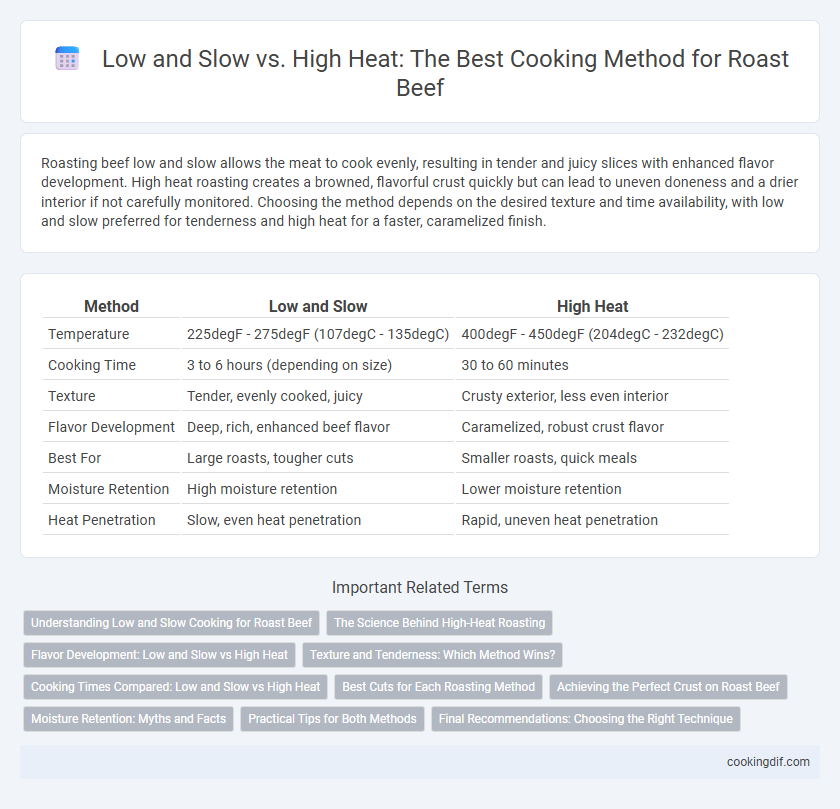Roasting beef low and slow allows the meat to cook evenly, resulting in tender and juicy slices with enhanced flavor development. High heat roasting creates a browned, flavorful crust quickly but can lead to uneven doneness and a drier interior if not carefully monitored. Choosing the method depends on the desired texture and time availability, with low and slow preferred for tenderness and high heat for a faster, caramelized finish.
Table of Comparison
| Method | Low and Slow | High Heat |
|---|---|---|
| Temperature | 225degF - 275degF (107degC - 135degC) | 400degF - 450degF (204degC - 232degC) |
| Cooking Time | 3 to 6 hours (depending on size) | 30 to 60 minutes |
| Texture | Tender, evenly cooked, juicy | Crusty exterior, less even interior |
| Flavor Development | Deep, rich, enhanced beef flavor | Caramelized, robust crust flavor |
| Best For | Large roasts, tougher cuts | Smaller roasts, quick meals |
| Moisture Retention | High moisture retention | Lower moisture retention |
| Heat Penetration | Slow, even heat penetration | Rapid, uneven heat penetration |
Understanding Low and Slow Cooking for Roast Beef
Low and slow cooking for roast beef involves maintaining an oven temperature between 225degF and 275degF to ensure even heat distribution and gradual breakdown of connective tissues, resulting in tender, juicy meat. This method typically requires several hours, depending on the roast size, allowing collagen to melt and enhance flavor without overcooking the exterior. Mastering low and slow techniques guarantees a consistent medium-rare to medium finish, preserving moisture and maximizing the beef's natural tenderness.
The Science Behind High-Heat Roasting
High-heat roasting of beef creates a Maillard reaction, which enhances flavor by forming complex, savory compounds and a caramelized crust. This method rapidly sears the exterior, locking in juices and preserving tenderness while developing a rich, browned surface. The intense heat also accelerates cooking time, making it ideal for achieving a crispy outside and medium-rare interior efficiently.
Flavor Development: Low and Slow vs High Heat
Roasting beef low and slow allows connective tissues to break down gradually, enhancing tenderness and developing deep, rich flavors through Maillard reactions over time. High heat roasting creates a sharp crust quickly, intensifying surface caramelization but can risk drying the interior and limiting full flavor development. Balancing heat methods optimizes both a flavorful crust and a juicy, tender interior.
Texture and Tenderness: Which Method Wins?
Low and slow cooking of roast beef enhances tenderness by breaking down connective tissues and collagen, resulting in a juicy, melt-in-the-mouth texture. High heat methods create a caramelized crust but can cause the interior to become tough and unevenly cooked. For optimal texture and tenderness, the low and slow approach consistently outperforms high heat roasting.
Cooking Times Compared: Low and Slow vs High Heat
Cooking roast beef low and slow at temperatures around 225-275degF results in longer cooking times, often 3 to 5 hours for a typical 3-5 pound cut, ensuring even heat penetration and tender, juicy meat. High heat roasting at 400-450degF dramatically shortens cooking time to approximately 1 to 1.5 hours but risks a less uniform internal temperature and potentially drier meat edges. Choosing low and slow maximizes collagen breakdown and flavor development, while high heat is suitable for quick cooking with a crispier exterior.
Best Cuts for Each Roasting Method
Prime rib and chuck roast excel with low and slow cooking, breaking down collagen and rendering fat for tender, juicy results. For high heat roasting, sirloin and ribeye deliver a flavorful crust while maintaining a medium-rare center. Selecting the appropriate cut for the roasting method enhances texture and taste, ensuring optimal roast beef quality.
Achieving the Perfect Crust on Roast Beef
Achieving the perfect crust on roast beef relies heavily on temperature control during cooking; starting with high heat sears the meat, forming a flavorful Maillard reaction crust that locks in juices. Following this, lowering the oven temperature allows the roast to cook evenly and tenderize without drying out the exterior. Low and slow methods enhance juiciness and tenderness but lack the intense crust development that high-heat searing provides, making a combined approach optimal for crust and texture.
Moisture Retention: Myths and Facts
Cooking roast beef low and slow preserves moisture by allowing collagen to break down gradually, preventing the meat from drying out. High heat methods can create a flavorful crust but often cause rapid moisture loss in the interior. Scientific studies confirm that controlled low temperatures optimize juiciness by minimizing protein coagulation and water expulsion.
Practical Tips for Both Methods
For roast beef, low and slow cooking at 225-275degF ensures even heat penetration and tender, juicy meat with a medium-rare center. High heat roasting at 425-450degF creates a flavorful crust quickly but requires careful monitoring to prevent overcooking. Use a meat thermometer to achieve the desired internal temperature of 130-135degF for medium-rare regardless of the method.
Final Recommendations: Choosing the Right Technique
Selecting the ideal roasting method for beef depends on the desired texture and flavor intensity; low and slow roasting at around 225-275degF ensures even cooking and tender, juicy results by breaking down connective tissues over several hours. High heat roasting at 425-500degF is best for creating a caramelized crust quickly, preserving a rare to medium-rare interior with less cooking time. For optimal final results, combining both techniques--starting with high heat to sear and finishing low and slow--maximizes flavor while maintaining moistness.
Low and slow vs high heat for roast beef Infographic

 cookingdif.com
cookingdif.com